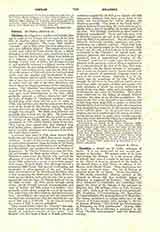

Sikhism, the religion of a warlike sect of India, having its origin in the Punjab and its center in the holy City of Amritsar, where their sacred books are preserved and worshipped. The name Sikh signifies “disciple”, and in later times the strict observants or elect were called the Khalsa. The founder of the sect, Nanak (now called Sri Guru Nanak Deva), a Hindu belonging to the Kshastrya caste, was born near Lahore in 1469 and died in 1539. Being from childhood of a religious turn of mind, he began to wander through various parts of India, and perhaps beyond it, and gradually matured a religious system which, revolting from the prevailing polytheism, ceremonialism, and caste—exclusiveness, took for its chief doctrines the oneness of God, salvation by faith and good works, and the equality and brotherhood of man. The new religion spread rapidly and, under the leadership of nine successive gurus or teachers soon became an active rival not only to the older Hinduism, but also to the newer Mohammedanism of the reigning dynasties. The “disciples” were therefore somewhat ill treated by the governing powers. This persecution only gave fresh determination to the sect, which gradually assumed a military character and took the name of Singhs or “champion warriors”; under Govind Sing, their tenth and last guru (b. 1660; d. 1708), who had been provoked by some severe ill treatment of his family by the Moslem rulers, they began to wage active war on the Emperor of Delhi. But the struggle was unequal. The Sikhs were defeated and gradually driven back into the hills. The profession of their faith became a capital offense, and it was only the decline of the Mogul power, after the death of Aurungzeb in 1707, which enabled them to survive. Then seizing their opportunity they emerged from their hiding places, organized their forces, and established a warlike supremacy over a portion of the Punjab round about Lahore.
A reversal took place in 1762, when Ahmed Shah badly defeated them and defiled their sacred temple at Amritsar. In spite of this reverse they managed still to extend their dominion along the banks of the Sutlej and the Jumna Rivers, northwards as far as Peshawar and Rawalpindi, and southwards over the borders of Rajputana. In 1788 the Mahrattas overran the Pun-jab and brought the Sikhs under tribute. Upon the Mahrattas supervened the British, who received the allegiance of a portion of the Sikhs in 1803, and later on, in 1809, undertook a treaty of protection against their enemy, Runjeet Singh, who, although himself a prominent Sikh leader had proved overbearing and intolerable to other portions of the sect. Various other treaties between the British and the Sikhs, with a view of opening the Indus and the Sutlej Rivers to trade and navigation, were entered into; but as these agreements were not kept, the British declared war on the Sikhs in 1845. By 1848, partly through actual defeat, partly through internal disorganization and want of leaders, the Sikh power was broken; they gradually settled down among the rest of the population, preserving only their religious distinctiveness intact. According to the census of 1881 the number of the Sikhs was reckoned at 1,853,426, which in the census of 1901 rose to 2,195,339. At the time of writing the census of 1911 is not yet published.
Their sacred books, called the “Granth” (the original of which is preserved and venerated in the great temple of Amritsar) consists of two parts: “Adi Granth”, the first book or book of Nanak, with later additions compiled by the fifth guru, Arjoon, and with subsequent additions from later gurus down to the ninth, and contributions by various disciples and devotees; secondly, “The Book of the Tenth King”, written by Guru Govind Sing, the tenth and last guru, chiefly with a view of instilling the warlike spirit into the sect. The theology contained in these books is distinctly monotheistic. Great and holy men, even if divinely inspired, are not to be worshipped—not even the Sikh gurus themselves. The use of images is tabooed; ceremonial worship, asceticism, and caste-restrictions are explicitly rejected. Their dead leaders are to be saluted simply by the watchword “Hail Guru” and the only material object to be outwardly reverenced is the “Granth”, or sacred book. In practice, however, this reverence seems to have degenerated into a superstitious worship of the “Granth”; and even a certain vague divinity is attributed to the ten gurus, each of whom is supposed to be a reincarnation of the first of the line, their original founder—for the Hindu doctrine of transmigration of souls was retained even by Nanak himself, and a certain amount of pantheistic language occurs in parts of the sacred hymns. Salvation is to be obtained only by knowledge of the One True God through the Sat Guru (or true spiritual guide), reverential fear, faith and purity of mind and morals—the main principles of which are strictly inculcated as marks of the true Sikh; while such prevailing crimes as infanticide and suttee are forbidden. They place some restriction on the killing of animals without necessity, but short of an absolute prohibition. Peculiar to the sect is the abstention from tobacco and in part from other drugs such as opium—a restriction introduced by Guru Govind Sing under the persuasion that smoking was conducive to idleness and injurious to the militant spirit. At the present time an active religious revival is manifesting itself among the Sikhs, having for its object to purge away certain superstitions and social restrictions which have gradually filtered in from the surrounding Hinduism.
ERNEST R. HULL

